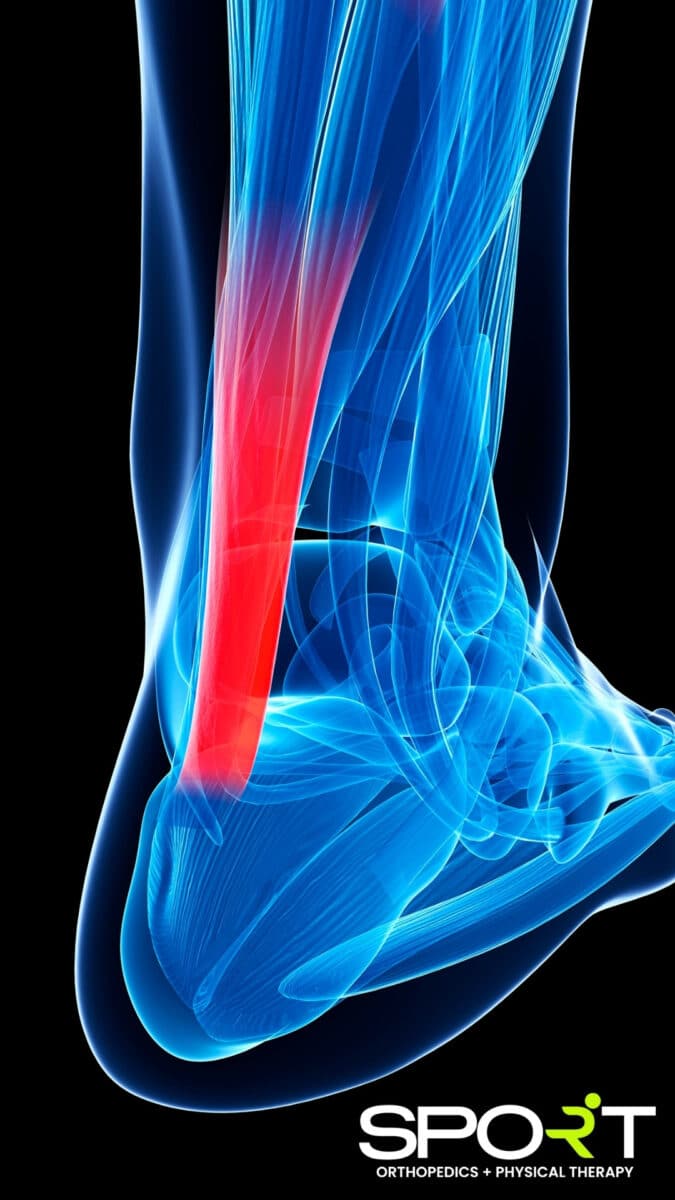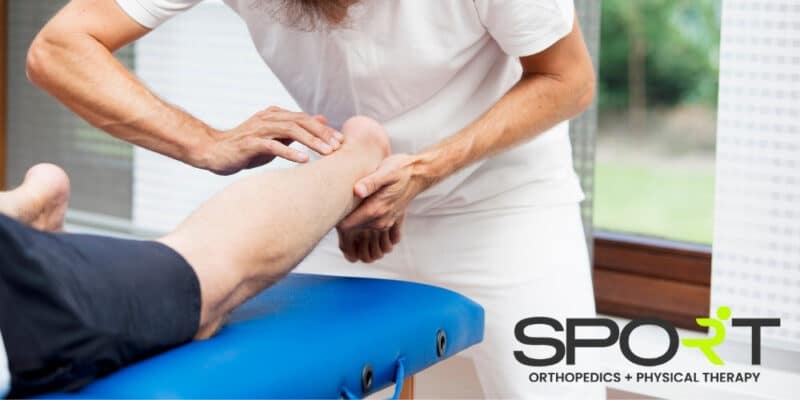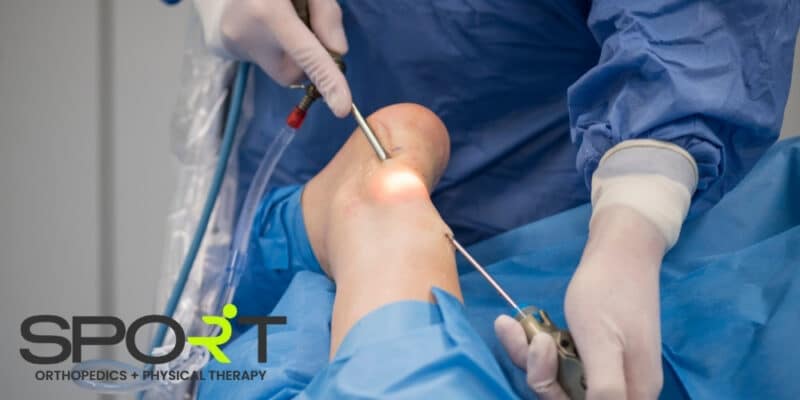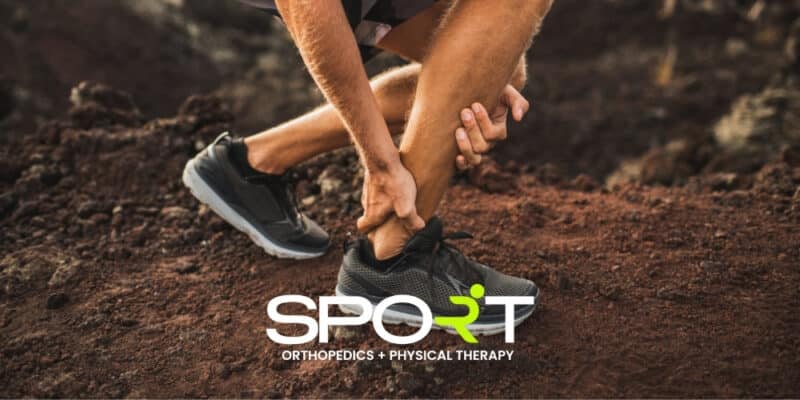Achilles Tendinitis Treatment in Dallas and Frisco, Texas
Achilles Tendon Injuries, Achilles Tendinopathy
An Achilles tendon injury can happen to anyone at any time, regardless if you’re an athlete or simply on your way to work. One common form of Achilles tendon injury is called Achilles tendinitis.
The Achilles tendon is the largest tendon in the human body, stretching from the heel bone to the calf muscle. If you place your fingers below your calf and above the back of your ankle, you can feel the stringy band. This muscle allows you to point your toes, as well as raise up on your tiptoes.
Because of the placement and size of the muscle, it’s common for the Achilles tendon to get injured. Injuries can range from mild to severe. If you suffered an Achilles tendon injury, contact the best orthopedic surgeon in Dallas to schedule an appointment at 469-200-2832 today. The professionals at SPORT Orthopedics + Physical Therapy are here for you.
Achilles Tendinitis Injuries
Achilles tendonitis is an injury that describes a part of the Achilles tendon becoming inflamed.
This condition is divided into two categories, depending on which parts of the Achilles tendon are injured.
Noninsertional Achilles Tendinitis
Noninsertional Achilles tendinitis occurs when the fibers in the middle of the Achilles tendon break down. This type of injury typically affects younger adults who are more active.
Over time, as the fibers begin to break down, they can cause the tendon to swell and become thick.
Insertional Achilles Tendinitis
Insertional Achilles tendinitis affects the lower heel area, where the tendon goes into the heel bone. This type of Achilles tendinitis can cause heel bone spurs. Insertional Achilles tendinitis can affect those of any age, including those who aren’t physically active.
In both non-insertional and insertional Achilles tendinitis, the damaged tendon fibers can calcify over time.
Achilles Tendon Rupture
Achilles tendonitis is different than an Achilles tendon rupture. An Achilles ruptured tendon is a condition in which the Achilles tendon becomes separated from the heel bone, or in some cases, completely torn in half.
An Achilles rupture typically results from a sudden injury and is usually more common for those playing sports.

Achilles Tendon Injury Symptoms
The most obvious sign of Achilles tendon injuries is pain above the heel bone, especially when you stretch your foot and ankle. This pain may be mild and get better or worse over time.
However, if the Achilles tendon ruptures, the pain will be instant and severe. Also, if you tear your Achilles tendon, you may hear snapping or popping after the tendon rupture. You may also have problems pointing your toes, flexing your calf muscles, or pushing off of your toes.
Besides pain and swelling, tight calf muscles, and limited range of motion, you may also experience the other common symptoms of Achilles tendinitis:
- Pain behind the heel when you touch or move it
- Heel pain in the morning
- Swelling that worsens when you’re walking or running
- Discomfort and swelling inside the back of your heel
- Inability to flex your foot
- Stiffness in the Achilles tendon when you first wake up
- A warm sensation around the injury
- Difficulty standing on tiptoes
- A thick band develops on the back of the heel bone
- Bone spur formation
If you’ve experienced a sudden pop on the back of the heel, you may have torn your Achilles tendon. You’ll want to seek treatment from our experienced foot and ankle surgeons at SPORT Orthopedic Surgeons in Dallas and Frisco.
What Causes Achilles Tendinitis?
With Achilles tendinitis injuries, overuse of the Achilles tendon usually causes swelling, inflammation, and irritation. Achilles tendon disorders are common among those who are active on their feet.
When we diagnose Achilles tendinitis, we understand that it isn’t usually tied to a specific injury. Instead, Achilles tendinitis occurs because a person has stressed the Achilles tendon repeatedly.
Because most people use their Achilles tendon all the time, the body doesn’t have time to self-correct and heal the injury.
Common Causes of Achilles Tendinitis
While Achilles tendinitis can happen to anyone, injuries to the Achilles tendon are more common for those who engage in actions where they quickly speed up, pivot, or slow down, occurring in activities such as the following.
- Baseball
- Basketball
- Dance
- Football
- Gymnastics
- Running
- Soccer
- Softball
- Tennis
- Volleyball
Tendon injuries usually happen when a person starts suddenly moving as they push off and lift the foot. We see this commonly in sprinters, football players, and gymnasts specifically.
Causes of Achilles Tendinitis in Older Adults
As you age, the gradual wear and tear will affect the Achilles tendon. For older adults, Achilles tendinitis can also be caused by arthritis.
Other common causes of Achilles tendinitis in older adults include:
- Completing strengthening exercises without first warming up or completing stretching exercises
- Straining the calf muscles during an exercise routine by excessive repeated movements
- Playing sports, such as tennis, without first consulting a physician for a physical exam
- A sudden increase in physical activity, without letting the body adjust
- Wearing shoes that don’t fit well
- Wearing high heels for extended periods of time
Haglund’s Deformity
In rare cases, an individual may be suffering from Haglund’s deformity. This is a condition in which an enlargement exists on the bone located on the back of the heel. This deformity can rub on the Achilles tendon and also cause inflammation and pain.
Risk Factors for Achilles Tendinitis
As stated, Achilles tendinitis occurs because of gradual wear and tear of the Achilles tendon. So, a number of preexisting factors can increase your risk of sustaining Achilles tendinitis, including but not limited to:
- Age: Achilles tendinitis becomes more common as you get older.
- Sex: Achilles tendinitis is more common in men.
- Medications: If you’re taking fluoroquinolones, a certain type of antibiotic, or a glucocorticoid, you may temporarily be at a higher risk for an Achilles tendinitis injury.
- Medical conditions: Those with Psoriasis or high blood pressure are at a higher risk of developing tendinitis.
- Physical problems: If you naturally have a flat arch, this puts more strain on the Achilles tendon. Furthermore, obesity and tight calf muscles also increase tendon strain.
- Training options: If you run in a worn-out or ill-fitting shoe, you increase your risk of Achilles tendonitis. Tendon issues tend to arise more in colder weather, and those who choose to run up hills also tend to have more ankle and foot issues, in general.
Achilles Tendinitis Diagnosis

General physicians sometimes mistake an Achilles tendon injury for sprained ankles. While mistakes can occur in any field, this is why we recommend seeking treatment from an organization that’s comfortable treating Achilles tendinitis. Our orthopedic surgeons and physical therapy staff have treated thousands of patients with Achilles tendon issues, and we know how to determine the cause of sports-related injuries more efficiently than a general physician could.
Walk Test
Because the symptoms of Achilles tendinitis can greatly vary, unless the patient is in terrible pain, we’ll ask to see them walk so that we can look for the problems that may have led to the injury.
Calf Squeeze Test
We may also perform a calf squeeze test. For this test, you’ll kneel on one of our benches or lie on the exam table. One of our orthopedic surgeons will gently squeeze the calf muscle on the healthy leg. This pulls on the tendon and makes the foot move. Next, we’ll do the same on your injured leg. If you’ve torn your Achilles tendon, this limits the range of motion.
MRI Scan
In some cases, we may go straight to an MRI scan or other imaging tests. This will show us exactly what type of tendon damage you’ve sustained and will help us determine the appropriate steps for treatment, whether that be Achilles tendon surgery or some time spent with a physical therapist.
Achilles Tendon Injury Treatment
Mild to moderate Achilles tendon injuries should heal up on their own. To speed up the healing process, you may want to:
- Rest your leg. Avoid putting weight on the leg by using crutches or a walking boot.
- Ice. You can ice the area where the Achilles tendon connects for up to 20 minutes at a time.
- Compress the area. Use an elastic bandage around the weak calf muscles and muscles to your heel in order to reduce swelling.
- Take anti-inflammatory medications. Anti-inflammatory drugs (NSAIDs), such as ibuprofen or naproxen sodium can help relieve pain and reduce swelling. You’ll want to consult with your doctor before taking any type of pain relief medication.
- Heel lifts. We may recommend that you wear a heel lift insert inside your shoe to promote healing and limit heel pain. This helps to prevent Achilles tendinitis and scar tissue from worsening.
- Practice stretching and strengthening the tendon. Only do this if it’s recommended by your orthopedic surgeon or physical therapist.
Achilles Tendon Surgery

If your Achilles is torn or if nonsurgical treatment isn’t helping, then we may recommend Achilles Tendinitis Surgery. For those who are young and in great health, apart from the damaged tendon tissue, the more likely the chances are of us recommending this surgery.
Most patients should have the surgery within around a month of the injury. One of our orthopedic surgeons will make a small incision on the back of the ankle and sew the Achilles back together.
In some cases, we may need to sew other tendons together to make sure everything will last and heal correctly. This is known as a tendon transfer.
We’ve seen an 80-90% success rate with Achilles tear and partial tear surgeries. Another successful option that we offer is Percutaneous Achilles Tendon Repair. If you’re unable to undergo surgery, other options do exist.
One nonsurgical treatment is physical therapy. At SPORT Orthopedics, we have some of the best physical therapists around who we know will put you in the best possible position for healing. Another nonsurgical option is shockwave therapy.
Dallas Achilles Tendinitis and Achilles Tendon Physicians
While acute symptoms of Achilles tendinitis tend to go away after a few days of rest and proper home treatment, some more moderate to severe injuries can produce severe pain that lingers for months.
A full Achilles tendon recovery can take much longer if you don’t seek the proper medical treatment. Our clinic offers emergency services and will do our best to see you as quickly as possible. You can schedule an appointment directly from our website or by calling our office at 469-200-2832.



